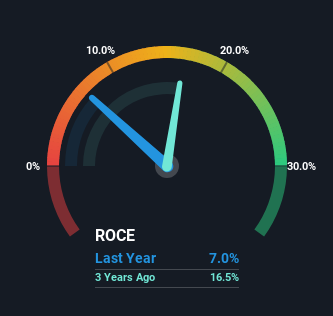Be Wary Of Billion Industrial Holdings (HKG:2299) And Its Returns On Capital

What are the early trends we should look for to identify a stock that could multiply in value over the long term? Ideally, a business will show two trends; firstly a growing return on capital employed (ROCE) and secondly, an increasing amount of capital employed. This shows us that it's a compounding machine, able to continually reinvest its earnings back into the business and generate higher returns. Having said that, from a first glance at Billion Industrial Holdings (HKG:2299) we aren't jumping out of our chairs at how returns are trending, but let's have a deeper look.
What Is Return On Capital Employed (ROCE)?
For those that aren't sure what ROCE is, it measures the amount of pre-tax profits a company can generate from the capital employed in its business. To calculate this metric for Billion Industrial Holdings, this is the formula:
Return on Capital Employed = Earnings Before Interest and Tax (EBIT) ÷ (Total Assets - Current Liabilities)
0.07 = CN¥713m ÷ (CN¥26b - CN¥16b) (Based on the trailing twelve months to December 2022).
So, Billion Industrial Holdings has an ROCE of 7.0%. Ultimately, that's a low return and it under-performs the Luxury industry average of 11%.
View our latest analysis for Billion Industrial Holdings

While the past is not representative of the future, it can be helpful to know how a company has performed historically, which is why we have this chart above. If you're interested in investigating Billion Industrial Holdings' past further, check out this free graph of past earnings, revenue and cash flow.
What The Trend Of ROCE Can Tell Us
In terms of Billion Industrial Holdings' historical ROCE movements, the trend isn't fantastic. Over the last five years, returns on capital have decreased to 7.0% from 11% five years ago. Meanwhile, the business is utilizing more capital but this hasn't moved the needle much in terms of sales in the past 12 months, so this could reflect longer term investments. It may take some time before the company starts to see any change in earnings from these investments.
On a side note, Billion Industrial Holdings' current liabilities have increased over the last five years to 62% of total assets, effectively distorting the ROCE to some degree. If current liabilities hadn't increased as much as they did, the ROCE could actually be even lower. What this means is that in reality, a rather large portion of the business is being funded by the likes of the company's suppliers or short-term creditors, which can bring some risks of its own.
Our Take On Billion Industrial Holdings' ROCE
Bringing it all together, while we're somewhat encouraged by Billion Industrial Holdings' reinvestment in its own business, we're aware that returns are shrinking. And investors appear hesitant that the trends will pick up because the stock has fallen 57% in the last five years. Therefore based on the analysis done in this article, we don't think Billion Industrial Holdings has the makings of a multi-bagger.
One more thing to note, we've identified 1 warning sign with Billion Industrial Holdings and understanding it should be part of your investment process.
While Billion Industrial Holdings may not currently earn the highest returns, we've compiled a list of companies that currently earn more than 25% return on equity. Check out this free list here.
Valuation is complex, but we're here to simplify it.
Discover if Billion Industrial Holdings might be undervalued or overvalued with our detailed analysis, featuring fair value estimates, potential risks, dividends, insider trades, and its financial condition.
Access Free AnalysisHave feedback on this article? Concerned about the content? Get in touch with us directly. Alternatively, email editorial-team (at) simplywallst.com.
This article by Simply Wall St is general in nature. We provide commentary based on historical data and analyst forecasts only using an unbiased methodology and our articles are not intended to be financial advice. It does not constitute a recommendation to buy or sell any stock, and does not take account of your objectives, or your financial situation. We aim to bring you long-term focused analysis driven by fundamental data. Note that our analysis may not factor in the latest price-sensitive company announcements or qualitative material. Simply Wall St has no position in any stocks mentioned.
About SEHK:2299
Billion Industrial Holdings
Develops, manufactures, and sells polyester filament yarns products, polyester products, polyester industrial yarns products, and ES fiber products in the People’s Republic of China and internationally.
Excellent balance sheet with proven track record.
Market Insights
Community Narratives




